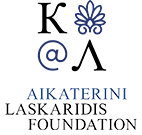Art and antiquities (4900 Subjects)
Leda from the now lost Incantadas monument, Thessaloniki.
Ariadne from the now lost Incantadas monument, Thessaloniki.
Dionysus with panther from the now lost Incantadas monument, Thessaloniki.
Maenad from the now lost Incantadas monument, Thessaloniki.
Inscriptions and shield reliefs from trophies, found near Stoa of Philip V, Delos.
Ancient altar from Myconos.
Plan of Doric columns and elevation of Doric colonnade together with entablature, possibly from the Temple of Apollo, Delos.
Temple of Apollo, Delos: Shaft, capital, and entablature of the columns.
Stoa of Philip V, Delos: Plan and elevation of the portico.
Stoa of Philip V, Delos: The shaft, capital, and entablature of the columns. The inscription is given by Tournefort, who visited Delos in the year 1700.
Stoa of Philip V, Delos: Elevations and section plans of the entablature and other architectural features.
Votive relief found on the wall of a school close to the church of Megali Panagia, Athens.
Relief found at a church at Marousi, Athens.
Roman colonnade close to the Choregic monument of Lysicrates: Fig. 1: Elevation of the columns. Fig.2: Plan of ditto. Fig.3: Plan of the capital. Fig. 4: Flank of the capital. Fig. 5: Section through the front of ditto. Fig. 6: Section through the flank of ditto. Fig.7: The spiral line of the volute, by a larger scale. Fig. 8: The section of the volute and abacus, which, by a mistake, has been put upside down. Fig. 9: Eye of the volute.
Roman colonnade close to the Choregic monument of Lysicrates: Fig. 1: The base, capital, architrave and frieze. Fig. 2: Profile of the internal face of the architrave.
Ruins of ancient building embedded into a residence, next to the Horologion of Andronikos Kyrristos (Tower of the Winds), Athens: Fig. 1: Elevation of the part remaining, which shews that there were not fewer than three arches. Fig. 2: Plan of ditto. Fig. 3: Capitals of the pilasters with the profile of the archivolt; the spandrel, which is a rose, projects equal to the upper facia of the archivolt, as shewn upon the right hand side, where the profile of the archivolt is given; but the projection of the central filet is shewn on the left from the flat surface of the spandrel. Fig. 4: Is the profile of the impost mouldings. Fig. 5: Section through the entablature, which is probably incomplete.Fig. 6: Spandrel with the rose. Fig. 7: Profile in the center between the two capitals of the pilasters, shewing the manner in which the mouldings finish against the background.
Title page. Altar from Ephesus, today at the British Museum.
Title page of the first part of the book. Tetradrachm from Agrigento, Sicily. Obv. Skylla.
Plans of the temples of Zeus and Heracles at Agrigento, Sicily. Map of the site.
Atlas from the Temple of Zeus at Agrigento, Sicily.
Plan of the Temple of Zeus at Agrigento.
Restoration of the Temple of Zeus at Agrigento, Sicily. On the left the Temple of Concordia and on the right the Temple of Athena.
Transverse section of the temple of Zeus at Agrigento.
Temple of Zeus at Agrigento, Sicily: Longitudinal section.
Outer peristyle of the Temple of Zeus at Agrigento Sicily: Fig. 1: View of crepidoma, base of the column, column, capitals and entablature. Fig. 2. Section plan of crepidoma, base of the column, capitals and entablature. Fig. 5. Plan of column.
Temple of Zeus at Agrigento, Sicily: Interior order of the cella.
View of the ruins of the Temple of Zeus at Agrigento, Sicily.
Views, plans, and section plans of various architectural features of the Temple of Zeus at Agrigento, Sicily.
Front view and plan of the Temple of Heracles at Agrigento, Sicily. View of column and entablature. Section plan of moulding.
View of the Pnyx. Plan and section plan of the bema, the orator's podium. Plan of the site of the Pnyx.































